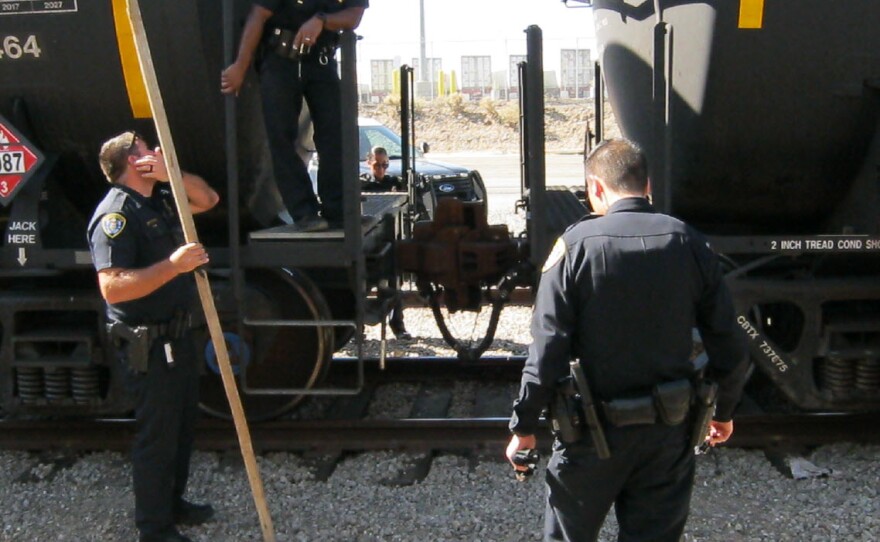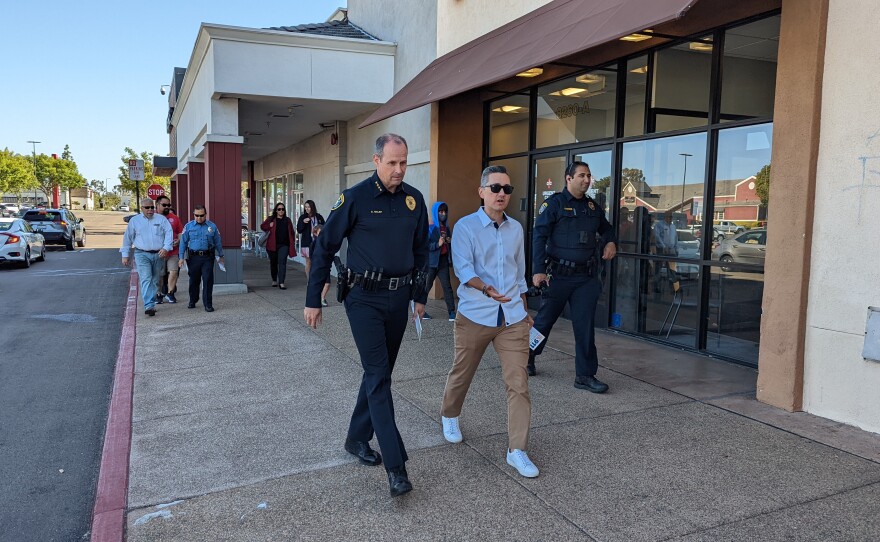This is the first of a two-part series. Read part two here.
Early on a Tuesday evening in July 2017, La Mesa Police Detective Jacob Wisler was in City Heights searching for a man suspected of homicide.
Wisler spotted 30-year-old Derrick Henderson walking down Altadena Avenue, so he jumped out of his patrol vehicle and chased him into an alley.
“He starts digging into his waistband,“ Wisler later told police investigators. “He seemed to be buying time to get something.“
There’s no body camera video available to back up Wisler's account. Moments later, Wisler fired several shots at the un-armed man. None of the rounds hit Henderson.
Roughly two years later, in October 2019, a worker at BNSF Railway on Cesar Chavez Parkway called the San Diego Police Department to report that a man was refusing to leave the premises.
When SDPD officers arrived, 65-year-old Douglas Nephew grabbed a fire extinguisher and sprayed them, according to a police report. Police ordered Nephew to stop. Instead, he walked away, first picking up a 10-foot wooden stick, then several railroad spikes.
Nephew threw a spike at officers, but they never fired their guns. Instead, they used bean bags, pepper balls and finally a police dog to subdue him.
Why was Henderson shot at, while police used less-than-lethal force on Nephew? That’s impossible to know for sure, as each interaction with police has its own set of circumstances.
But there is one aspect of the two cases that likely impacted their outcomes: Henderson is Black and Nephew is white.
The cases were among the more than 460 police use-of-force incidents involving San Diego County police agencies dating back to 2000. In cases where suspects were people of color, police fired their weapons 64% of the time. When they were white, just over 48% of the time.
Here is a sampling of other use-of-force cases involving people of color:
- In April 2015, a San Diego Police officer shot and killed Fridoon Nehad, who suffered from mental illness and was walking in an alley with a metal pen in his hand.
- In September 2016, El Cajon police shot and killed Alfred Olango, who was having a mental health crisis and pointed a metal vape pen at responding officers.
- In 2016 and again in 2019, officers shot men who raised shovels.
- In July 2018, Sheriff’s deputies shot a man who walked toward them with his hand outstretched in front of him.
The SDPD and Sheriff’s Department account for 85% of the records, with the rest coming from smaller agencies like the La Mesa Police Department.
In response, San Diego Police Capt. Jeffrey Jordon sent a statement saying: “Research reveals force used by officers has a correlation to the levels of resistance used by persons against them during interactions. Additionally, factors such as mental illness, substance abuse, and certain locations are also factors that contribute to uses of force.“
He added that SDPD uses force in roughly 2% of their stops and the department's new Force Analysis Unit reviews every single use of force and makes training recommendations to "reduce force applications where possible."
In a statement, San Diego Sheriff's spokesperson Lt. Amber Baggs said the department “recognized the need to revamp and improve the training we provide to our deputies for a multitude of responses that have historically been at higher risk for deadly force incidents.“
Baggs said five years ago, the department developed a de-escalation training program and is now working with the District Attorney's office on that training.
“We know from our ongoing critical review of incidents that we have made significant progress,“ Baggs said. “Many current cases which would have previously resulted in a use of force or potentially deadly force incident now result in our safely taking individuals into custody.“Disparities everywhere
The realities in San Diego County mirror those nationwide. In January to March 2022, police in the United States have shot and killed an average of three people a day, and just 44% of them were white, according to the nationwide advocacy organization Campaign Zero’s Mapping Police Violence project.
“The racial disparities show up in almost everything that we measure,” said DeRay Mckesson, a civil rights activist and executive director of Campaign Zero. “We are confident that people's lived experience is also true when they think about the disparities.”
The records analyzed by KPBS were released under SB 1421, a state law that went into effect in 2019 and for the first time requires police agencies statewide to make public internal records, video and audio related to police shootings and use of force resulting in great bodily injury.
Local police agencies would not obey the law when it was first passed, forcing KPBS and other news organizations to fight legal battles for the records. It wasn’t until this year, four years after the bill became law, that the agencies released all the required records.
The findings of the KPBS analysis are consistent with other large-scale studies of police use of force both locally and nationwide. Brian Finch, a USC professor of sociology and spatial sciences, created his own database of police killings across the country. He said the disparities remain regardless of circumstances.
“I think this is another indication that these disparities that you're observing are real and not necessarily just dependent on different types of crime being committed by or different types of stops occurring for different demographic subgroups like Black and white citizens,” Finch said.
A study by Campaign Zero found 93 police killings in San Diego County from 2013 to 2021. Among those killed, 34% were white, the study showed, even though white people make up 43% of the county’s population.

Attempts at solutions
Several local programs are attempting to tackle these disparities and make it less likely that police use lethal force in general.
In March 2019, San Diego County District Attorney Summer Stephan rolled out an eight-hour de-escalation training program for local law enforcement agencies, and now most officers have taken it. Stephan said she’s seeing a slight tick down in the number of police shootings — from 18 a year to 15 or 16 a year in the past two years — but said she would want five years’ worth of numbers to be more positive about the connection between de-escalation training, along with other factors like department policy changes regarding de-escalation.
“Despite the fact that more and more people have guns and now we're seeing that more and more people have also ghost guns,” Stephan said. “So it is a scary situation out there for officers, a lot more guns on the streets, but we're still seeing the numbers go down a bit which is very encouraging.”
Local police departments have made their own policy changes, many of them mandated by the state. They include new training on non-bias policing, de-escalation and leadership and community outreach.
The SDPD has updated its use-of-force policy to require that officers make specific efforts to de-escalate a situation before drawing their guns. The department has also set up community walks in city neighborhoods and is focusing on hiring more diverse officers.

Racism remains
For many community members, it’s too little, too late. They say there’s racism among police officers that can’t be overcome with training.
“If a police officer learns Southeast San Diego is where the gang bangers are and you’ve got to keep your head up because they're going to be shooting at you, then yeah, he's going to be more likely to use lethal force there,” said Darwin Fishman with the Racial Justice Coalition of San Diego.
There are also other contributing factors to more shootings of people of color, Fishman said. For example, people of color have less access to mental health services, which can mean more calls to 911 for a mental health crisis.
“We're more reluctant to go to traditional doctors, mental health providers, counselors, therapists,” Fishman said. "That means when there’s a mental health problem, law enforcement is more likely to be called ... It’s just a recipe for disaster."
To make a dent in this continuing disparity, and to reduce police shootings in general, Campaign Zero and other advocates say there should be fewer interactions with police.
“That really requires understanding the data, what officers are being dispatched to, or what they are actually initiating themselves and trying to basically do an inverse approach of how urban policing has been sort of developed in the last century,” said Abdul Nasser Rad, the managing director of research and data for Campaign Zero. “And then when officers are engaging with civilians, we increase accountability and deterrence factors to allow for de-escalation alternatives and a harm reduction approach.”
Fishman said he sees resistance from police officers to reforms aimed at decreasing shootings, pointing to the San Diego Police Officers’ Association’s campaign against the PrOTECT Act, a proposal that would require police to have probable cause in order to stop, ask for identification, question, or search people.
“Police have to be much more open and receptive to understand that there's room for change and that the community is deeply concerned and upset about these issues,” he said.
Fishman hopes that in a year, police will embrace de-escalation the way they first resisted body cameras, but now generally view them as essential to their job.
“It can't be smoke and mirrors, there has to be substantial change,” he said. “You're going to build up more trust in the community, you're going to literally have less people killed.”







